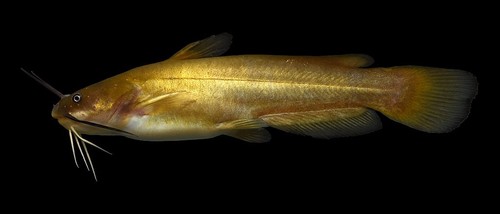
Yellow Bullhead
The Atlantic bluefin tuna (Thunnus thynnus) is a highly migratory, large pelagic fish renowned for its size, speed, and commercial value. It plays a critical role in the marine ecosystem and supports significant fisheries.
4 7 years
Lifespan
20 - 30 cm
Length
Least Concern
Conservation Status
5 km/h
Swimming speed
Omnivorous, Detritivorous, Scavengers
Diet
Local Migration
Migration
Appearance Overview
The Atlantic bluefin tuna has a robust, streamlined body built for speed and endurance. It exhibits a metallic blue dorsal side and a silvery-white underside.
Coloration
Dark metallic blue on top, silvery-white on bottom
Body Shape
Torpedo-shaped, streamlined
Fins
Two dorsal fins, the first is depressible; small finlets run down the back and belly towards the tail
Keel
Strong lateral keel on the caudal peduncle
Length
Up to 13 feet (4 meters), commonly around 6.5 feet (2 meters)
Weight
Up to 2,000 lbs (907 kg), commonly around 550 lbs (250 kg)
Diet
Carnivorous; feeds on a variety of fish (such as herring, mackerel, and hake), squid, crustaceans, and occasionally zooplankton.
Feeding Behavior
Opportunistic and highly active predator. Bluefin tuna use their speed and agility to chase down prey, often feeding near the surface but also diving to considerable depths. They can exhibit cooperative hunting behavior.
Social Behavior
Forms large schools, especially when young. Schools can be mixed with other tuna species. Adults are more solitary but still aggregate during spawning.
Commercial Relevance
Extremely high value, particularly in the sushi and sashimi markets, where individual fish can be sold for hundreds of thousands or even millions of dollars. It is also important in recreational fisheries.
Conservation measures
Subject to international fishing quotas and regulations managed by organizations like ICCAT. Marine Protected Areas (MPAs) and fishing gear restrictions are also in place in some regions. Efforts are ongoing to improve stock assessments and reduce illegal fishing.
Status
Near Threatened (population increasing)
Threats
Historical overfishing drastically reduced populations. Current threats include continued fishing pressure (both legal and illegal), bycatch in other fisheries, and potential impacts from climate change affecting prey distribution and spawning habitats.
Habitat Distribution
Depth Range
0-1,000 meters (0-3,280 feet), most commonly found in the epipelagic zone (surface to 200 meters).
Geographic Range
Found throughout the North Atlantic Ocean, including the Mediterranean Sea. Two main spawning grounds: the Mediterranean Sea and the Gulf of Mexico.
Preferred Environment
Primarily pelagic, inhabiting temperate and subtropical waters. They undertake long migrations across the Atlantic.
Reproduction and Life Cycle
Breeding Habits
Spawns in warm waters, primarily in the Mediterranean Sea and the Gulf of Mexico. Spawning typically occurs from spring to summer.
Development Stages
Eggs are pelagic and hatch into larvae. The larvae are planktonic and undergo rapid growth. Juveniles form schools and gradually mature into adults.
Fecundity
Highly fecund; a large female can produce up to 30 million eggs per spawning season.
Maturity Age
Reaches sexual maturity at around 4-8 years in the Mediterranean and 8-12 years in the Gulf of Mexico.
Faqs about Yellow Bullhead
How fast can Atlantic bluefin tuna swim?
Atlantic bluefin tuna are among the fastest fish in the ocean, capable of bursts of speed up to 40-60 mph.
How long do Atlantic bluefin tuna live?
They can live for up to 40 years, although the average lifespan is closer to 15-25 years.
Are bluefin tuna warm-blooded?
Yes, they are warm-blooded, which allows them to maintain a higher body temperature than the surrounding water, aiding in muscle efficiency and allowing them to thrive in a wider range of temperatures.
Can you eat bluefin tuna?
Yes, but it depends on the origin and the specific population. Consumers should look for sustainably sourced bluefin tuna and check resources like the Monterey Bay Aquarium's Seafood Watch guide.
What organization manages bluefin tuna populations?
ICCAT (International Commission for the Conservation of Atlantic Tunas) is the primary organization responsible for managing bluefin tuna populations.
What is the largest bluefin tuna ever caught?
The record is over 1,496 pounds. The heaviest recorded were caught off the coast of Nova Scotia.
Copyright @ Nature Style Limited. All Rights Reserved.
 English
English